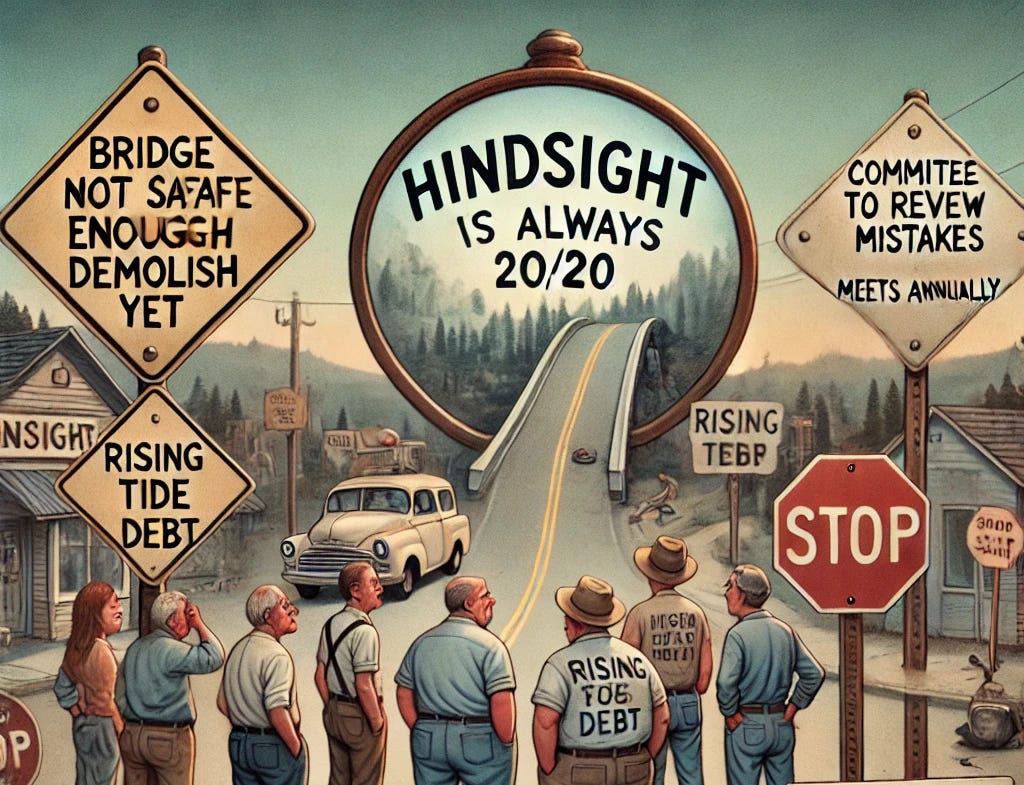City Disproves Theory That Hindsight Is Always 20/20
Little benefit to be gained from focusing on, learning from, past actions and decisions that failed say City Staff.
CITY HALL– City officials stood in front of the City Hall building that was recently renovated for the second time in seven years to announce that they were going to stubbornly persist in doing things the way they’ve always done things, despite decades of evidence suggesting that they shouldn’t.
The City faces sky-rocketing taxes due to 30 years of anti-growth policies that choked out net-positive smart growth to expand the tax base, annual increases in water and sewer fees and debt service to offset the $70+ million in municipal debt the City incurred after rejecting Federal Funding to pay for 50% of the cost of storm-water separation in a short-sighted effort to block new development.
The stagnant downtown resulting from a misguided decision to re-route traffic away from the historic center was followed by a series of planning efforts over the course of decades that cost over $500,000 in analysis alone but never seemed to amount to anything.
Lack of interest in, desire to learn from, past mistakes“troubling” say political scientists
Despite sufficient evidence to establish that what they have done in the past hasn’t worked, the City appears content to keep doin’ as it’s doing.”
The City vows to continue ignoring the advice of land use experts that the City and State government have themselves contracted (at taxpayer expense), to study: the economic impact and tax revenue implications of smart growth, the City’s sufficient infrastructure capacity for additional growth while maintaining more open space and conservation land than any comparable municipality in the State; and the procedural barriers to housing creation resultant from existing land-use policies, all which illustrate the often unintentional but nonetheless adverse outcomes of past policy decisions.
“We are tired of taking on the region‘s growth,” said the city of approximately 15,000 that benefits from municipal water and sewerage that can support the residential and commercial growth necessary to meet the needs of a growing City at the crossroads of two major interstates, and which serves as the regional center of industry, commerce, and retail.
City to persist doing things the way they always have, despite all evidence to the contrary
“It’s time for housing to go elsewhere,” said City leadership, which regional planners note would mean the municipality wouldn’t gain property tax value from the thousands of people who currently commute to the City for work each day, utilize city services, and then drive home without paying taxes to the City.
“We have enough traffic already” said the planning department that had developed, defended, and over-zealously enforced exclusionary zoning policies that intentionally separated residential and commercial uses, all but requiring citizens to drive to every errand of their day.
“This city can’t take any more growth” said members of the Planning Board and Conservation Commission, which had recently commissioned studies seeking to limit further development to retain the rural character of the 15,000 person municipality.
However, the results of those independent analyses empirically demonstrated that the City has sufficient land, water, and sewer capacity to support considerably more growth while still balancing the inherent impacts on the natural environment.
Past decisions remembered, repeated.
“We don’t want more density,” said a Board Member, seeming to willfully ignore the decades of studies, nationwide best practices, and examples from throughout the world that dense development downtown is a better solution than the alternative result of sprawling single family homes and subdivisions, that which could not be supported with municipal services without contributing to more to the municipal maintenance deficit.
“Our children don’t have enough recreation spaces and outdoor opportunities” said chair of the Conservation Commission, which voted against the expansion of trails and playing fields on public land behind a strip-mall.
“We need to maintain a natural buffer between the river and the box stores,” said the Chair, in reference to the corridor of tertiary growth, invasive species, and trash atop the man-made riverbank full of sewer and natural gas infrastructure, where a contiguous trail network along the river was required of property owners but the City has failed to enforce and denied requests to re-establish as an accessible river front trail.
“Developers have failed to build sufficient housing to meet the demands of the region,” said the Planning Director responsible for limiting housing development through outdated zoning, burdensome conditions, and egotistical enforcement.
In response to the housing crisis– and instead of addressing the policies that continue to lead to adverse results– the City plans to build affordable housing itself, but has yet to determine how much it would cost to construct the housing units, how much they would sell for, or why it is so difficult to navigate the approval process.


